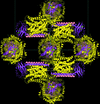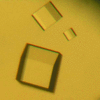issue contents
December 2007 issue

Cover illustration: Allophycocyanin from Thermosynechococcus elongatus [Murray et al. (2007), Acta Cryst. F63, 998-1002].
structural genomics communications
The crystal structure of the minimized α/β-hydrolase fold protein encoded by the gene TTHA1544 from T. thermophilus HB8 has been determined at 2.0 Å resolution.
PDB reference: minimized α/β-hydrolase fold protein, 2dst, r2dstsf
protein structure communications
The crystal structure of a light-harvesting protein that interacts with photosystem II is reported.
PDB reference: allophycocyanin, 2v8a, r2v8asf
The crystal structure of MnSOD with four dimers per asymmetric unit was refined to an R factor of 21.1% at 1.8 Å resolution. Differences in the monomer fold and dimer interface relative to the human enzyme can be exploited in the design of selective drugs for Bacillus MnSOD.
PDB reference: MnSOD, 2rcv, r2rcvsf
nucleic acid structure communications
The structure of the complex of the hexanucleotide duplex d(CGCGCA)·d(TGCGCG) with hexammineruthenium(III) ion shows a tautomeric shift in the adenine base and a consequent disruption of the A·T base pair.
crystallization communications
A vertebrate-type [2Fe–2S] ferredoxin (FdxB), which is probably involved in the iron–sulfur cluster-biosynthesis system of the γ-proteobacterium P. putida JCM 20004, has been crystallized in space group P6122. The needle-shaped crystals of recombinant FdxB diffract to 1.90 Å resolution using synchrotron radiation.
I-Dmo-I is a well characterized homing endonuclease from the archaeon Desulfurococcus mobilis. The enzyme was cloned and overexpressed in Escherichia coli. Crystallization experiments of I-Dmo-I in complex with its DNA target in the presence of Ca2+ and Mg2+ yielded crystals that were suitable for X-ray diffraction analysis.
The production and crystallization of human leukocyte antigen class II molecules HLA-DQ2 and HLA-DQ8 in complex with deamidated gliadin peptides is reported. Crystals of HLA-DQ2PQPELPYPQ diffracted to 3.9 Å, while the HLA-DQ8EGSFQPSQE crystals diffracted to 2.1 Å, allowing structure determination by molecular replacement.
The C-terminal catalytic domain of serine/threonine kinase RSK1 has been crystallized; the crystals diffracted to a resolution of 2.7 Å and belonged to space group P21.
Mutation of symmetry-related (in space group P43212) glutamate and lysine residues on the water-exposed surface of an integral membrane protein, cytochrome ba3, from T. thermophilus leads to robust crystallization of the protein in space group P41212; crystals of these mutant proteins show X-ray diffraction to molecular resolution.
A highly diversified novel immune-type receptor from catfish, NITR10, was crystallized to reveal novel mechanisms of immune recognition.
HA3, a 70 kDa haemagglutinating protein, is a precursor form of HA3a and HA3b, the subcomponents of Clostridium botulinum type C 16S progenitor toxin. In this report, recombinant HA3 protein was overexpressed in Escherichia coli, purified and crystallized.
In this study, the Korean pine (Pinus koraiensis) vicilin-type 7S seed storage protein was isolated from defatted pine-nut extract and purified by sequential gel-filtration and anion-exchange chromatography. Well diffracting single crystals were obtained by the vapour-diffusion method in hanging drops.
The cloning, expression, purification and crystallization of the CBM3b module of cellobiohydrolase 9A from C. thermocellum is described. The crystals diffract to 2.68 Å.
A putative member of the haloacid dehalogenase superfamily from T. onnurineus has been expressed, purified and crystallized using 1.6 M magnesium sulfate as a precipitant. The crystals belonged to the triclinic space group P1 and diffracted to 1.8 Å resolution.
The crystallization of ybfF, a new esterase from E. coli, and the collection of diffraction data to 1.1 Å resolution are reported.
The expression, purification and crystallization of human 5-lipoxygenase-activating protein in complex with two leukotriene-biosynthesis inhibitors is decribed. The processes that were used to generate diffraction quality crystals are presented in detail.
ScpB from M. tuberculosis was crystallized using the sitting-drop vapour-diffusion method in the presence of 2 M NaCl and 10% PEG 6000 at 295 K. X-ray diffraction data were collected to a maximum resolution of 2.3 Å at a synchrotron beamline.
The antiproliferative complex Tob–hCaf1 was purified and crystallized using the sitting-drop vapour-diffusion method. The crystal diffracted to around 2.6 Å resolution.
Crystals scattering to 2.00 Å resolution have been obtained of the ydjA nitroreductase from E. coli K12.
Crotoxin B is a basic phospholipase A2 found in the venom of C. durissus terrificus and is one of the subunits that constitute crotoxin. Here, the crystallization, X-ray diffraction data collection and molecular-replacement solution of a novel tetrameric complex formed by two dimers of crotoxin B isoforms are presented.
Crystals of the plant Rho protein ROP5 from A. thaliana have been obtained that diffract to 1.53 Å resolution.
Crystals of baculovirus-expressed adeno-associated virus serotype 7 capsids have been produced which diffract X-rays to ∼3.0 Å resolution.
The expression, purification and crystallization of the small laccase from S. coelicolor are reported. Diffraction data were collected to 3 Å resolution.
Three data sets have been collected on endothiapepsin complexed with the gem-diol inhibitor PD-135,040: a high-resolution synchrotron X-ray data set, a room-temperature X-ray data set and a neutron diffraction data set. Until recently, it has been impossible to grow large protein crystals of endothiapepsin with any gem-diol inhibitor that are suitable for neutron diffraction.
Nucleoside diphosphate kinase from B. anthracis has been crystallized. Preliminary crystallographic analysis shows that there is one monomer in the asymmetric unit of the crystal.
A ternary complex of the proteinase inhibitor (BTCI) with trypsin and chymotrypsin was crystallized and its crystal structure was solved by molecular replacement.


 journal menu
journal menu





































![[publBio]](/logos/publbio.gif)





